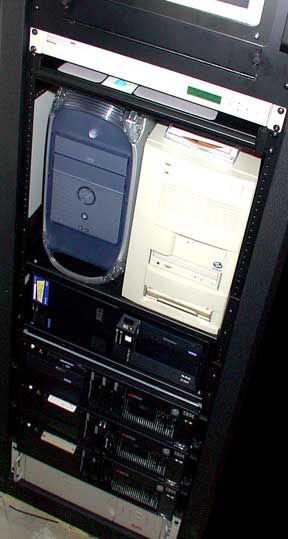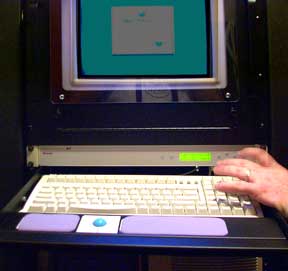 |
| FTLComm - Tisdale - Thursday, August 16, 2001 |
 Yesterday the NASDAQ composite stock market listing reached its lowest point since April when all investors wanted to do was sell, sell, sell. This morning NASDAQ fell another 26.83 points to 1,892. In yesterday's trading the of the top one hundred companies listed only five did not experience losses. We need to understand what is driving this unusual loss of confidence in the technological sector of the world economy. Just two years ago investors of every type were putting their money in high tech companies, either hardware, software or Internet commerce because it seemed that the sky was the limit and everyone wanted to be part of that rising economic bubble. Common sense is not considered a part of the stock market world so we need not fret over what amounts to be gambling with property values. But the computer and technology world needs to be examined to understand just what has been taking place. Up until three years ago this writer changed the computer on or under his desk every six months. This wasn't just to keep up with the blazing speed of change and innovation but it was also because it was necessary to stay abreast of those innovations and take advantage of them in the real working world. With the advent of the Macintosh G3 in December of 1997 we had computers to use that did what we had always said they would do, that is this was the real thing, not vapourware or hot air it was a working computer that was stable and powerful. It was not much later after that when Intel based computers running Windows 98 began appearing and for the first time PC computer uses also had a working computer that was all and more than most people needed. |
 In February of 1999 we sold our G3 and began using the modern Yosemite motherboard G3 Pro and though we changed computers every six months in the past that same machine is still in use creating this story. (The Yosemite had some growing pains but once things caught up to it its replacement was only marginally superior certainly not worth spending money for the switch) The only change from the 1999 machine to the present G4 is operating speed which has moved from 300mhz to 800mhz. These numbers are not really relevant because a Macintosh 300mhz functions at about the speed as a Pentium running at 600mhz. The same is the case for PC computers during these past two years only speed has increased and the addition of more easily handled peripheries like CD burners and cameras. Essentially the world of computer technology has moved from childhood (Apple //e and llgs) to adolescence; Performa 5200s and Pentium 166 machines and we are now into adulthood. The industry and the capabilities have grown up, oh we are far from maturity and will continue to see amazing capabilities becoming common place but the equipment can do work. Day after trouble free day of work. To accompany this maturity the operating systems be they Windows 98, ME, 2000, NT or Apple's 9.1 are stable and have reduced the user's need to be a computer expert. Apple computer users will soon all be switching the the UNIX based OSX and in a very short while new PC computers will be fitted with the new Windows operating system that is troubling the US justice system so much. The new operating systems further have advanced the means to the end and as a result users, both corporate and individuals have not been switching the machines on and under their desks as we all once did. This slow down in purchasing has really hit the industry so that most computer hardware companies, if they are still in business are on the edge of collapse. The market place is saturated with low priced high quality equipment as manufacturers have been building for the same turn over that once was the standard of about eighteen months but |
 this equipment of today and yesterday is hanging in there performing up to par without need of replacement. In Canada we have seen the wholesalers dropping like flies and the retailers quickly moving into service and content areas to stay in business. The future of computer technology is troubled but not a world of blight. Macintosh computers, the iMac sells for around $1,600 while PCs running windows are making it to market without monitors for around $600. The next big trend will be the switch over from CRT monitors to flat panels and that will work through the market in the next two years. The big change in technology and the reduction in the need for performance with the machine on or under your desk is the Internet connection itself. We are steadily moving from dial up modem connections to DSL and cable modems online all the time and that is where the developments are taking place. |
| Networks, in the workplace and online are the main focus throughout the computing
world and this means that things are tough for manufacturers because hundreds rather
than thousands of units will be all that will be going out the door. The pictures
on this page show the main heart of a business network for a Winnipeg retail and
technology company. At the top we see their router system with its wires that link
each work station to the system. Then we see the server stack consisting of a Mac
G4 server, a PC box and three IBM servers all controlled by a single monitor and
keyboard. This kind of system doles out Internet connections, point of sale, accounting, sales departments, service and rentals effortlessly and completely invisible to the users. |
 The three IBM servers that slide out of the rack on trays are the most interesting of this development. Each of these are multiprocessor high capability computers with loads of storage capacity and lightening fast response. But what is most interesting is what they are asked to do. Computer applications, the working software of any business or work station is constantly changing and a business can get mired down in handling the costs and upkeep of this software. In this system the software that is used throughout the business is in these servers. When a user logs in from where they are their software, |
 their files and their own preferences are available. What is intriguing about this concept is that the software is completely platform independent. They can use the iMac on their own desk, the PC in the accounting office, or a terminal somewhere else and the software the way they see it and how it acts is the same everywhere. It will be only a short while until this is the way most of us will be using computer software. We will log in to our system and application software coming from a server and we will go to work. The performance of our computer will be only minimal and we will be able to do what we need to do for the cost of a monthly user fee from the serving company. In time more and more of us who once paid our bills by selling computers will earn a living by providing content and serving up information and applications for our online customers. There will continually be a shakedown in the hardware and software industries, more than 80% will go out of business but the cost to the user will continue to decline and the performance and capabilities will incrementally improve. We in the graphics world will come more and more to depend on specialised equipment and software while business and sales people will come to rely more and more on off the shelf and online software that satisfies more general needs. The two factors that will continue to make the whole business of technology more and more capable are storage and memory. Memory prices for our machines continues to fall and hard drive storage with CD and DVD backup continues to be cheap. NASDAQ is melting down but the public and consumer are getting better stuff for less and less, it is a natural consequence of the technological evolution. |